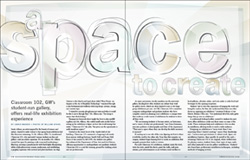A Space to Create
Classroom 102, GW's student-run gallery, offers real-life exhibition experience
Sarah Allison, an artist inspired by the beauty of science and nature, wanted to make visitors to her spring thesis exhibition feel like they were swimming. So Ms. Allison, MFA '11, transformed Classroom 102—the university's unique student-run fine arts gallery—into an artistic aquarium. For six months, Ms. Allison created the space by painting a side room and broadcasting a film loop, erecting a greenhouse lit with black lights illuminating tables of phosphorescent ceramic mushrooms, and establishing a gurgling aquarium with seaweed and photosynthetic sea slugs. Visitors to the March and April show, titled "Flora Forms: An Inquiry in the Art of Biophilia Technology," wandered through a dim bioluminescent walkway with long fringy curtains, strings, and cassette tape.
"I wanted to recreate phosphorescent water and what it would be like to move through that," Ms. Allison says. "I'm trying to mimic that whole feeling."
Planning her thesis solo show taught her how to plan and fill a gallery, says Ms. Allison, who crafted small-scale models before setting up her exhibition to figure out how she would arrange her works. "Classroom 102," she adds, "has given me the opportunity to really transform a space."
Nestled in the street level of the Smith Hall of Art building, Classroom 102 commands a lingering look inside from anyone walking between Smith Hall and Rome Hall. Since it was created in fall 2008, the student-run gallery has enhanced the Department of Fine Arts and Art History, offering opportunities to undergraduate and graduate students. Classroom 102 is a real-life training ground for budding artists and art professionals.
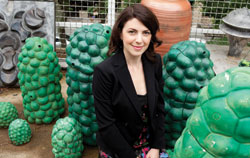
Sarah Allison, MFA '11, transformed Classroom 102 for her spring thesis exhibition "Flora Forms: An Inquiry in the Art of Biophilia Technology."
At many universities, faculty members run the university gallery, deciding how often students can submit their work for gallery shows, which are often limited to one or two large group exhibitions per year. At GW, Classroom 102's committee comprises undergraduate and graduate students who have complete control in planning every exhibition—a unique twist that results in a wide variety of exhibitions for students to show off their work.
"We are training students to become artists, art historians, and a variety of other arts professionals," says Dean Kessmann, associate professor of photography and chair of the department. "They need a space where they can develop the skills necessary to succeed."
If creating art is one side of the coin, figuring out how to share it with the world is the other side. From their first semester on campus, students begin learning how to create an exhibition that uniquely presents their works to viewers.
For each Classroom 102 exhibition, students create the work, write the texts, install the shows, paint the walls, craft press releases, post advertisements on art websites, send out fliers to local galleries, advertise online, and even make or order food and beverages for the opening receptions.
Students "get to have the experience of hanging the work and being the curator, but they also understand that there are other factors in organizing an exhibition," Assistant Professor of Art History Bibiana Obler says. "You understand all of the nitty-gritty things that go into an exhibition."
A professional-looking booklet, created by students for each show, offers exhibition credits and short essays on some of the works. These catalogues help each exhibition to live on after de-installation, allowing works to reach a wider audience.
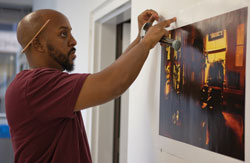
Wesley Clark, an MFA student, hangs a work in Classroom 102.
Designing an exhibition is "more work than I was expecting when I started curating," junior Blair Bainbridge says. Curators must get students to submit work, figure out installation logistics, then quickly de-install at the end—returning Classroom 102 to its original, white-walled state. By playing curator, students learn what types of tape, nails, and other materials to use for gallery installations. Students also learn basic professional installation techniques, including methods of hanging artwork.
Among the benefits of exhibiting work is the opportunity for response and critique. "It sometimes helps to have a critique in an actual gallery space because you're thinking about installation and taking ownership over how the object is installed," Dr. Obler says. "The challenge is: How do you make a show look good and fill the space effectively?"
Such valuable critiques come not just from professors, but from art professionals who can offer expert advice and comments.
"The great thing about GW is being so close to all the museums, so we have connections with the Phillips Collection and the Hirshhorn," Ms. Allison says. "Often, there's a visiting artist who comes to lecture, then they'll come to critique us…Having these famous artists come to look at our work and talk to us has been invaluable."
Last year, Ms. Bainbridge had the opportunity to show one of her installed video pieces to D.C. artist Jim Sanborn. Her video was projected 4 feet wide on a gallery wall, in a closed room where viewers peered through a window. "It was so much better than showing him in the studio, where I'd be showing him on my computer," says Ms. Bainbridge, who interns at Connor Contemporary Art gallery in D.C. "We had way more to talk about."
Opening receptions for most of the exhibitions offer even more opportunities for faculty, staff, students, and visitors to have informal conversations about art. In the winter's first-year MFA student show, titled "Incoming", Master of Fine Arts student Wesley Clark hung a series containing 12 untitled photographs presenting a private dancer and two more photos from a separate body of work.
Mr. Clark says that much of his education has come from seeing how his work comes across to others and determining from their reactions whether he successfully communicated his thoughts or purpose.
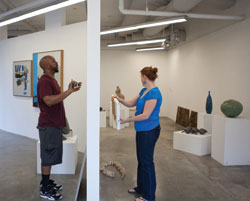
Students Wesley Clark and Caranine Smith prepare for an exhibition in Classroom 102.
"So much of the learning experience for me comes in hearing and seeing how people are interacting with the work," Mr. Clark says. He had particular views on one of his photograph series, "yet two grad students…who happened to be walking by the window during the reception came in and blew my mind with a whole different interpretation of the work."
In the same show, Larry Cook, MFA '12, displayed six portrait photographs produced during the fall semester. Each photograph in the exhibition was hung by pins, he explained, and "deciding which height and the distance to hang them took some effort. The Classroom 102 gallery helps me as an artist [to] anticipate some of the challenges and decisions that are presented when you install an exhibition."
The gallery's shape and distinctive wall of windows influenced Mr. Cook to hang his photographs higher than the standard gallery procedure. "I wanted to grab the attention of the people passing by the gallery day and night," he says. "The gallery allowed me to see the potential of my work."
In addition to small groups of students who create exhibitions, a few annual shows help structure the year's schedule. December's annual weeklong holiday sale offers students a chance to sell their art, and artists usually give a small percentage of the sale back to the gallery. Winter brings the Presidential Scholars in the Arts show. Graduate thesis shows typically run two weeks each in the spring. Every May, a juried show open to all GW students—art majors and non-majors—is judged by artists and curators from outside the university, with cash prizes totaling more than $10,000.
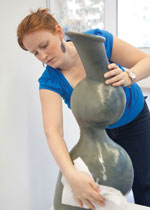
Classroom 102 co-coordinator Caranine Smith prepares a sculpture for exhibition.
This year's May awards show was judged by Jayme McLellan, founding director of Civilian Arts Projects, a gallery representing emerging and established artists in Washington, D.C.
Classroom 102 also offers opportunities for GW's fine arts program to collaborate with the art history program. Art history students help hatch exhibition themes, serve as curators, coordinate studio visits with fine arts students to select the works, and write essays about the exhibition or works.
"Bridging this divide has allowed all of the department's students to be actively involved in this communal space," Mr. Kessmann says.
Mr. Kessmann remembers when the department held student exhibitions in the Dimock Gallery in the basement of Lisner Auditorium. At the Dimock Gallery, which was not under the department's administrative control, faculty members were more involved in the day-to-day operations.
But in the transformed space of Classroom 102, "we get to decide what the shows are, how we're going to curate them, how we're going to hang them—there's a lot of possibility," says Ms. Bainbridge, who has so far shown work in eight Classroom 102 exhibitions and attends committee meetings. "It's a pretty rare opportunity to have a gallery that shows student work this regularly."
Visiting campus? Stop by Classroom 102 Monday through Friday from 9 a.m. to 5 p.m. Visit art.gwu.edu/classroom-102 to see what current exhibitions are showing.

